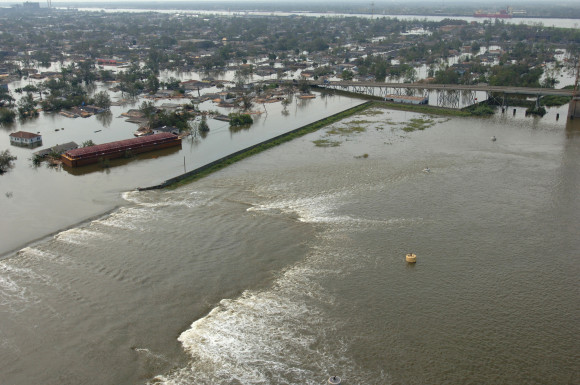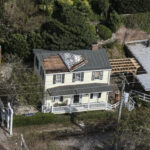In a 25-year span leading up to 2005, homeowners insurers in Louisiana wrote a total of $13 billion in homeowners insurance premium, from which they earned $1 billion in profit, according to the chief actuary at the state insurance department.
But in one day, Aug. 29, 2005, the day Hurricane Katrina made landfall on the southeastern shores of Louisiana, homeowner insurance carriers there lost $8 billion, said Richard Piazza with the Louisiana Department of Insurance.
That’s just one statistic out of many from the recent “State of Insurance Markets Ten Years Post-Hurricanes Katrina and Rita Summit” hosted by the Louisiana Department of Insurance on Aug. 11, 2015, that illustrate the magnitude of the storm and its impact on the state of Louisiana.
Hurricane Katrina was “the worst insured loss event in the history of insurance anywhere in the world. Bigger than 9/11, bigger than the earthquake and tsunami in Japan. Bigger than Hurricane Andrew, which had always been the benchmark event,” said Louisiana Insurance Commissioner Jim Donleon, speaking at the summit. “Katrina was the worst of all. Then three weeks later, our second worst event of all time, Hurricane Rita, visited the southwest corner of our state.”
Hurricane Katrina resulted in a combined $41 billion in insured losses in all states it affected, which in addition to Louisiana and Mississippi included Alabama, Florida, Georgia and Tennessee. Out of the more than 1.7 million Hurricane Katrina insurance claims filed, around 56 percent were in Louisiana, 29 percent were in Mississippi, according to the Insurance Information Institute.
Combined, Hurricanes Katrina and Rita accounted for $29 billion in insured losses in Louisiana alone — $25.5 billion in insured losses from Katrina, $3.5 billion in insured losses from Rita. Those figures exclude flood losses.
A total of 930,000 claims were filed in the state resulting from the two storms — 725,000 from Katrina and 205,000 from Rita.
Before the dual 2005 hurricanes, the largest insured loss in Louisiana was from Hurricane Andrew in 1992, which prior to Katrina had been the source of the largest catastrophe loss in the United States. Louisiana suffered one-half billion dollars in insured losses from Andrew.
Katrina was “devastating not only to Louisiana policyholders, but the insurance industry too. I don’t think they expected something this severe. But they stood up and did a great job in Louisiana to maintain the marketplace,” Piazza said in a presentation at the summit.
The numbers not only reflect dollars, but lives too. Nearly 1,600 Louisiana citizens lost their lives as a result of Hurricane Katrina. Around half of them were elderly.
Many lost their lives “not from what Katrina did but from the levee systems in the aftermath. … They bet on the fact that as so many times before they would come through, we would be fine, the sun would come out the day after and everything would be OK,” Donelon said. “And when the levees broke and 10 feet of water entered their homes, they were in attics and in 95 degree heat … with 95 percent humidity. At 80 years of age there’s no way to survive four days without food or drinkable water.”
A Poster Child for Recovery
The future of New Orleans and the state is brighter now “in large part because of the recovery of our insurance market. It is a recovery that was based upon a private sector path of recovery and not the state getting in the insurance business,” Donelon said. “It is a remarkable private sector-based recovery that I truly believe it is the poster child for how to do recovery from the worst insurance loss in the history of insurance anywhere in the world.”
In many ways, a one-for-all, all-for-one mentality helped keep the state from becoming mired in the backwash, so to speak.
“What we did right is everyone worked together,” said Blythe Lamonica with the Coalition to Insure Louisiana, who also spoke at the summit.
After the dual hurricanes hit Louisiana in 2005, “the federal government basically said, ‘you need to learn from this, we’re not going to give you any money until you all start working together.’ And that’s exactly what we did,” Lamonica said.
It began with the first ever statewide building code. Then-Gov. Kathleen Blanco, the business community, and the regulatory and the governmental bodies all came together for the first special session after the hurricanes to work on them, she said.
“We had probably a hundred different special interest groups working together on that building code. And let me tell you to get contractors and plumbers and inspectors and mayors from all across the state to come together and agree to one building code was a task in itself. … And it passed unanimously. There was no dissent,” Lamonica said.
Donelon credited the “responsible posture” of the legislature and state government, as well as the insurance carriers, insurance agents and others in the private sector — consumers, homebuilders, realtors, bankers and more — for their roles in both moving the recovery process along and creating a better insurance environment than what was in place before the storms.
But some praise Donelon himself and the agency he leads.
In a recently released statement, Bradley Kading, president and executive director of the Association of Bermuda Insurers and Reinsurers (ABIR), which represents the interests of 20 commercial insurers and reinsurers with underwriting operations in Bermuda, said: “The steady hand of Louisiana Insurance Commissioner James Donelon is responsible for the creation of a stable and competitive property insurance market in Louisiana in the years following the devastation left by Hurricane Katrina. …
“As the country faced its worst-ever hurricane loss event and the Southeast tried to dig out from seven of the largest land-falling hurricanes in 2004 and 2005, it would have been politically expedient for policymakers to shift the home insurance market to state run enterprises. Instead, Commissioner Donelon focused policymakers on important hazard mitigation measures such as the new statewide building code and efforts to attract new home insurers to the market in an attempt to reduce an overconcentration that had previously existed in a few leading carriers. By welcoming private sector insurers and reinsurers, Commissioner Donelon eliminated regulatory red tape, and gained the support of the governor and state legislature along the way.”
More Insurers, Smaller Citizens
Following the 2005 storms, many insurance companies exited the state and the market share of the state’s property insurer of last resort, Louisiana Citizens Property Insurance Corp., grew. In 2008, the number of Citizens’ policies peaked at 174,000; in May 2015 Citizens had 86,645 policies on its books.
That 50 percent reduction is the result of a focused effort to recruit new insurers into the state and incent them to take policies off of Citizens’ book.
Today, there are 22 new property insurers writing business in the state that were not there in 2005, according to the LDI.
Many of them are smaller, regional companies, but “they are financially sound, reputable insurers that are writing policies for homeowners and businesses across our state backed by the international reinsurance market,” Donelon stated in a report released by the LDI on the state of the insurance market 10 years after Hurricane Katrina.
While the property insurance market has improved significantly since the storms, it had a long way to go even before the 2005 hurricane season.
“We didn’t have a very good insurance market before Katrina and Rita,” Lamonica said. “We were basically below zero to begin with.”
Then-Insurance Commissioner Robert Wooley; Donelon, who was chief deputy commissioner at the time; Jeff Albright, executive director of the Independent Insurance Agents and Brokers of Louisiana; and Richard Clements with Louisiana’s Professional Insurance Agents Association had been traveling around the country trying to encourage insurers to enter the state’s property market.
Now, even with the many regulatory reforms and the influx of new property insurers offering consumers more options for coverage for their homes and businesses, costs remain high.
Louisiana ranks as one of the top three states with the highest homeowners insurance rates, along with Florida and Texas.
Still, said IIABL’s Albright, “insurers have come back, we have a fairly competitive marketplace, people can now get insurance. It’s not cheap, but it’s reasonably priced and readily available.”
Related:
- 10 Business Insurance Lessons and 1 Owner’s Advice from Katrina
- 10 Years After Katrina, Coastal Cities Face Greater Flood Risk: RMS
- Beyond Katrina: Lessons in Mitigation, Insurance and Community
- 10 Years After Katrina/Rita Louisiana Citizens’ Market Share at 1.8%
- Louisiana’s Homeowners Market Stronger 9 Years after Katrina
Topics Catastrophe Natural Disasters Carriers Agencies Profit Loss Legislation Louisiana Reinsurance Hurricane Property Homeowners Market
Was this article valuable?
Here are more articles you may enjoy.



 Viewpoint: Agentic AI Is Coming to Insurance Industry – Much Faster Than You Think
Viewpoint: Agentic AI Is Coming to Insurance Industry – Much Faster Than You Think  US E&S Outlook No Longer Positive: AM Best
US E&S Outlook No Longer Positive: AM Best  Lawsuit Alleges Farm Bureau Financial Concealed Fraudulent Activities
Lawsuit Alleges Farm Bureau Financial Concealed Fraudulent Activities  How ‘Super Roofs’ Reward Insurers, Cat Bond Investors and Homeowners
How ‘Super Roofs’ Reward Insurers, Cat Bond Investors and Homeowners 

